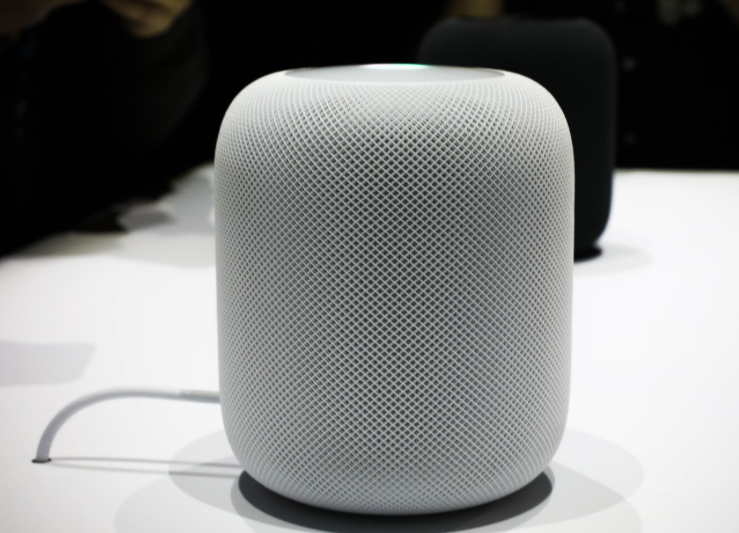Apple’s HomePod continues smart speaker trend
March 6, 2018
Following in the footsteps of Amazon and Google, Apple recently released their own voice-controlled smart speaker named the HomePod. Announced in early June last year, the HomePod became available to pre-order on Jan. 26, with the first orders arriving Feb. 9.
Equipped with Apple’s voice assistant Siri, the HomePod can perform the same commands as other Apple devices, such as setting a reminder for an event, reporting the latest news, or making and answering phone calls. In addition to Siri’s usual functions, it also connects with smart homes, allowing users to control functions such as dimming the lights or setting the temperature.
Weighing in at around five and a half pounds, the HomePod boasts excellent sound quality with its seven tweeter array, enhancing higher frequency sounds, combined with a powerful woofer to create bass. Furthermore, the new device adjusts its sound depending on its location to direct the sound waves for optimal performance.
Along with the technological benefits, the HomePod’s exterior design is simplistic yet sleek. With its round edges, the HomePod separates itself from the sharp edges of the Amazon Echo and the Google Home. The two options for color, which also appear on many of Apple’s devices, are white and space gray, which add to the minimalistic theme of the speaker.
However, Apple’s new creation sits on the pricier side, with a retail price of $349. Compared to Google Home’s $129 and Amazon Echo’s mere $99, Apple’s Homepod is much less affordable than its counterparts.
Unlike Amazon Echo and Google Home, the HomePod is only limited to Apple products.
“I think it’s another example of Apple’s failures to cooperate with industry norms,” Sanjay Rajasekharan (10) said. “If you look at all the other smart speakers they are all typically compatible with other music streaming platforms, but obviously Apple will not do that, and you can only use it on your Apple Music account. Other things, it’s only compatible with iPhones, which renders it useless for someone like me who prefers Android. So they basically lock out the majority of the population from using their product.”
Also, Amazon and Google released their voice controlled speakers much earlier than Apple did, with the Echo in 2014 and Google in 2016. The two other companies have developed other AI products as well with items like the Echo Dot or the Google Home mini, much cheaper products with similar capabilities as their parent speakers.
Apple’s recent involvement with smart-speakers is yet another result of the growing trend in artificial intelligence. Amazon is starting to expand its smart product line with the release of the Echo Spot and the Echo Show, two devices with displays, as well as a 2nd generation Echo. Meanwhile, other companies like Sonos and JBL, two businesses specializing in sound, are jumping on the trend with their own smart speakers, the Sonos One and the JBL Link.


















![“[Building nerf blasters] became this outlet of creativity for me that hasn't been matched by anything else. The process [of] making a build complete to your desire is such a painstakingly difficult process, but I've had to learn from [the skills needed from] soldering to proper painting. There's so many different options for everything, if you think about it, it exists. The best part is [that] if it doesn't exist, you can build it yourself," Ishaan Parate said.](https://harkeraquila.com/wp-content/uploads/2022/08/DSC_8149-900x604.jpg)




![“When I came into high school, I was ready to be a follower. But DECA was a game changer for me. It helped me overcome my fear of public speaking, and it's played such a major role in who I've become today. To be able to successfully lead a chapter of 150 students, an officer team and be one of the upperclassmen I once really admired is something I'm [really] proud of,” Anvitha Tummala ('21) said.](https://harkeraquila.com/wp-content/uploads/2021/07/Screen-Shot-2021-07-25-at-9.50.05-AM-900x594.png)







![“I think getting up in the morning and having a sense of purpose [is exciting]. I think without a certain amount of drive, life is kind of obsolete and mundane, and I think having that every single day is what makes each day unique and kind of makes life exciting,” Neymika Jain (12) said.](https://harkeraquila.com/wp-content/uploads/2017/06/Screen-Shot-2017-06-03-at-4.54.16-PM.png)








![“My slogan is ‘slow feet, don’t eat, and I’m hungry.’ You need to run fast to get where you are–you aren't going to get those championships if you aren't fast,” Angel Cervantes (12) said. “I want to do well in school on my tests and in track and win championships for my team. I live by that, [and] I can do that anywhere: in the classroom or on the field.”](https://harkeraquila.com/wp-content/uploads/2018/06/DSC5146-900x601.jpg)
![“[Volleyball has] taught me how to fall correctly, and another thing it taught is that you don’t have to be the best at something to be good at it. If you just hit the ball in a smart way, then it still scores points and you’re good at it. You could be a background player and still make a much bigger impact on the team than you would think,” Anya Gert (’20) said.](https://harkeraquila.com/wp-content/uploads/2020/06/AnnaGert_JinTuan_HoHPhotoEdited-600x900.jpeg)

![“I'm not nearly there yet, but [my confidence has] definitely been getting better since I was pretty shy and timid coming into Harker my freshman year. I know that there's a lot of people that are really confident in what they do, and I really admire them. Everyone's so driven and that has really pushed me to kind of try to find my own place in high school and be more confident,” Alyssa Huang (’20) said.](https://harkeraquila.com/wp-content/uploads/2020/06/AlyssaHuang_EmilyChen_HoHPhoto-900x749.jpeg)










